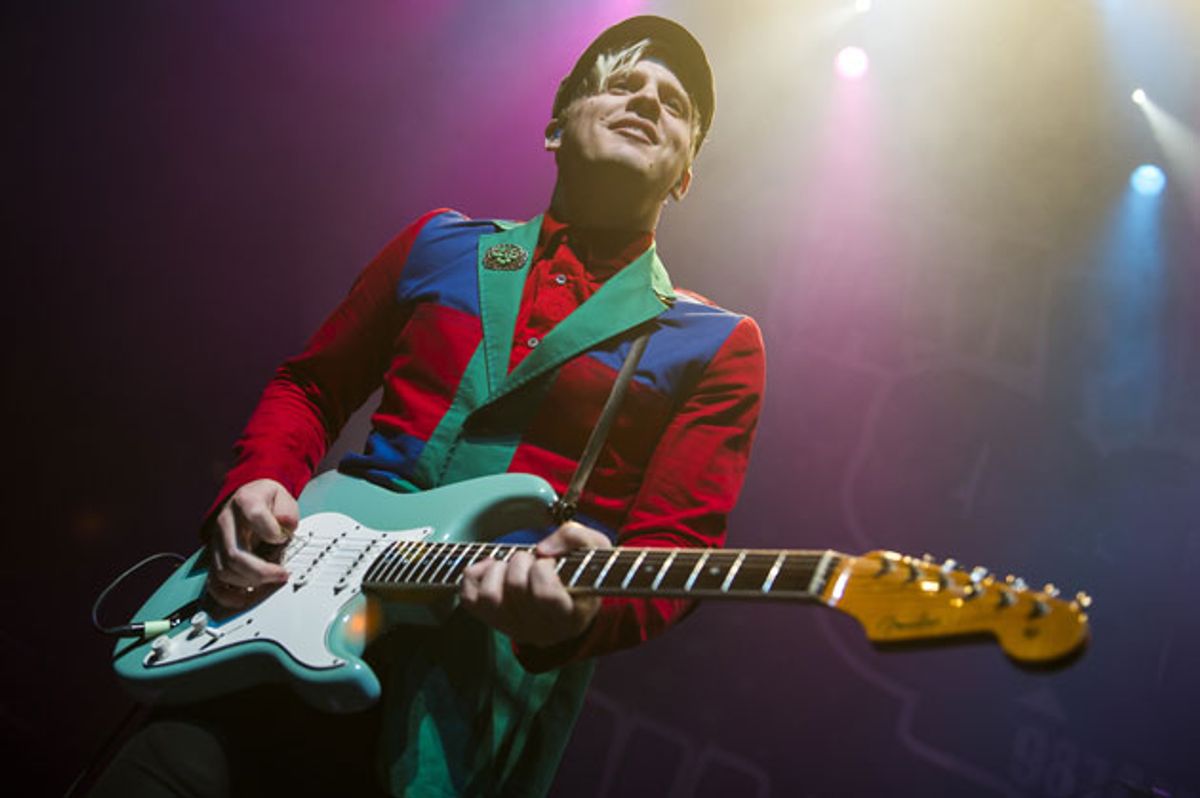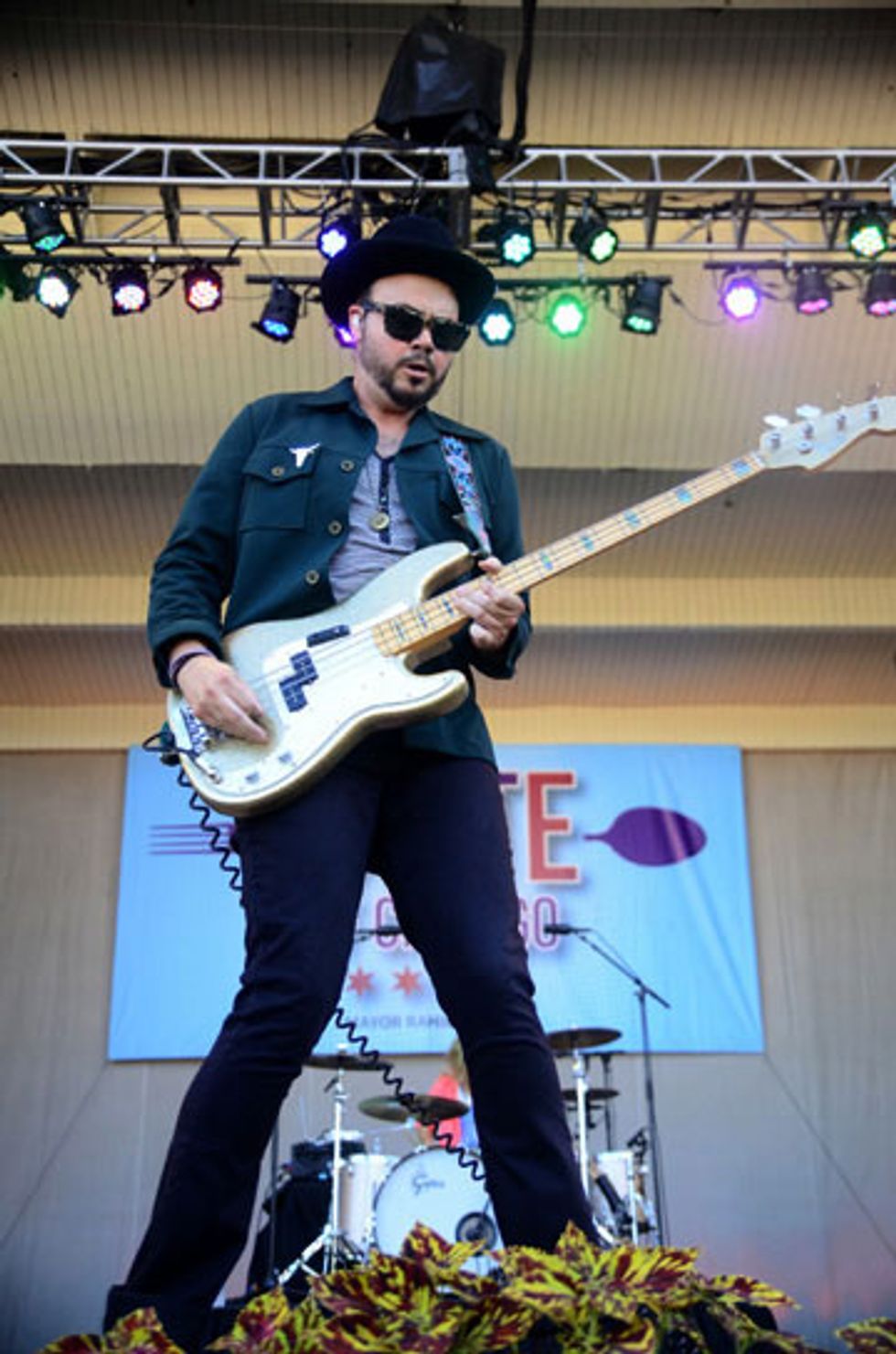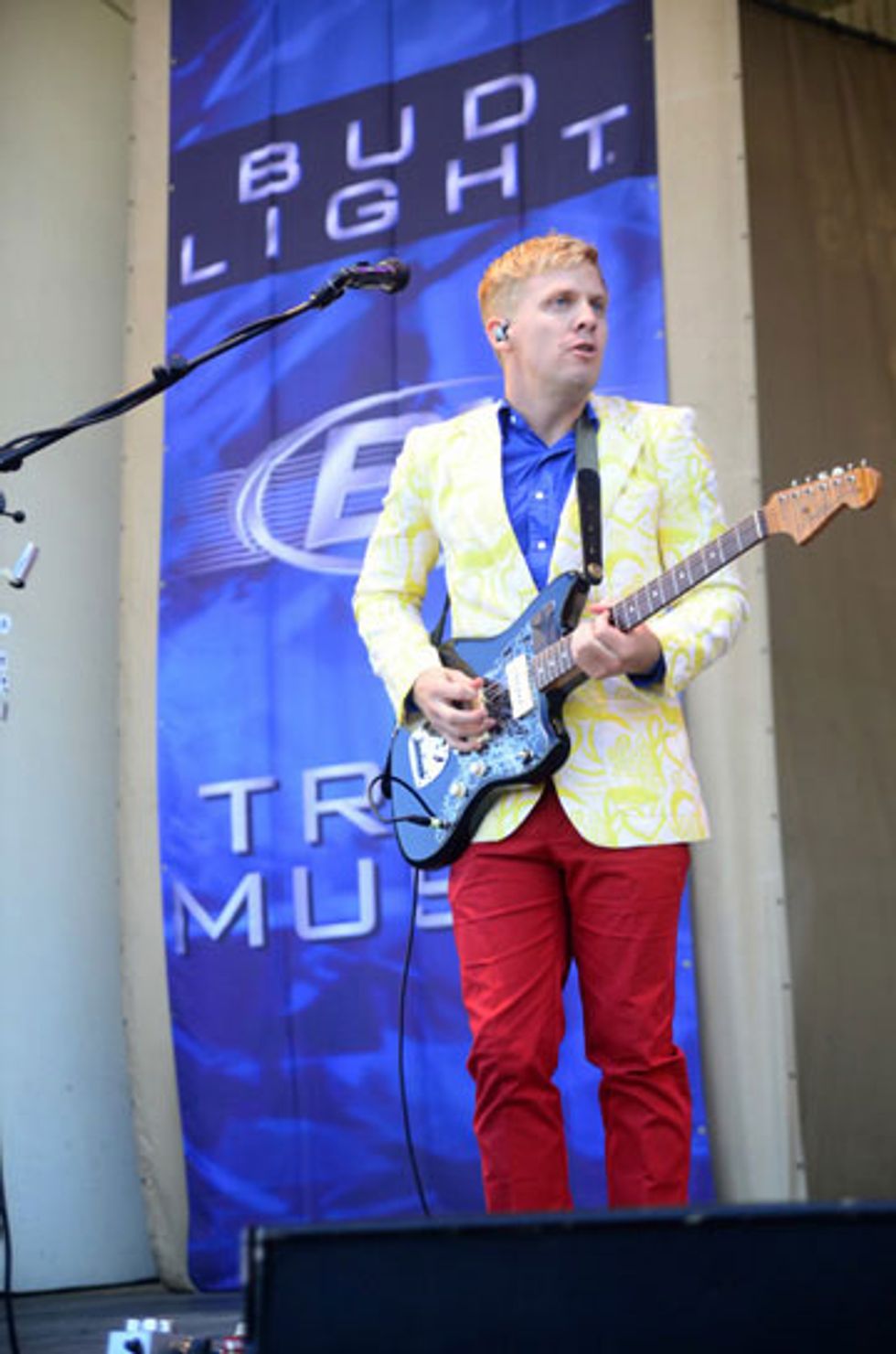Guitarist Chris Allen and bassist Branden Campbell discuss playing with nuance in Neon Trees, an alt-pop rock band with a sound that could be described as new new wave.
Neon Trees, the modern pop band that is musically and sartorially indebted to new wave, might rely heavily on synthesizers to achieve its dance-approved approach. But on its latest album, Pop Psychology (Island Records), the very first sounds—the transient rasp of an instrument cable, followed by the ringing open D and G strings—give a hint of both the importance and the subtlety of the guitar on the record.
Throughout the album, Chris Allen doesn’t play standard-issue rock guitar but something more thoughtful. His collection of riffs and timbres, plus the occasional oddball atonal move, feel spontaneous and orchestrated, and pair nicely with that of his bandmate Branden Campbell, who’s style is equally informed by such great session bassists as Donald “Duck” Dunn and by Campbell’s contemporary counterparts like John Stirratt of Wilco.
The roots of Neon Trees—whose name was inspired by the signage of In-N-Out Burger, the fast-food joint headquartered in Southern California—go back to Allen’s childhood days. He and Tyler Glenn, the group’s singer and keyboardist, were neighbors in Murrieta, California. When Allen took off to college in Utah, Glenn followed him, and there they eventually teamed up with bassist Campbell and drummer Elaine Bradley, independently releasing a debut EP, Becoming Different People, in 2006.
Before Neon Trees, Campbell was involved with, among many other bands, a ska group with the drummer Ronnie Vannucci, Jr., who would go on to join The Killers. After witnessing an early live show of Neon Trees, Vannucci was suitably impressed by his former bandmate’s new outfit, and as a result Neon Trees got its big break in opening for The Killers on its 2008 tour. This led to the Trees scoring a record deal with Mercury Records, which released Habits (2010) and Picture Show (2012), respectively spawning the hit singles “Animal” and “Everybody Talks.”
As was revealed a few years ago in our PGRig Rundown, Allen and Campbell might be described as major gear heads, aficionados of equipment both new and vintage, so we were excited to check in with them on their most recent rigs and hear about the thought processes behind Pop Psychology.
Tell us about your gear.
Chris Allen: My main guitar is an Eric Johnson Strat, and then I have a Telemaster that I had a Master Builder at Fender—Jason Smith, I used to play with him in high school—make for me. It’s got a Jazzmaster body and neck pickup but a Telecaster bridge and bridge pickup and selector switch. The neck profile is the same as on the Eric Johnson model guitar, and it has this 12-string-like headstock. I also had him build me a guitar based on a ’48 Esquire prototype with one TV Jones pickup and the whole thing painted a uniform color, Ford Grabber blue, so that it looks like a big hunk of plastic. Then I have a Jazzmaster and a bunch of guitars I only use in the studio. And I really like old Silvertones, which have such unique voices. I’m always picking them up on eBay or when we’re out on tour, at local shops. My favorite is the black-and-white hollowbody Silvertone, the 1446 that everybody calls the Chris Isaak model.
Live I use a Laney Lionheart, the L20H with a matching 2x12 cab, as well as a Roland JC-120. I also use those amps in the studio, plus a Divided by 13 JJN 50/100, a Silvertone Twin Twelve, and a Fender Hot Rod Deluxe. The main pedal on my board is an Ibanez Tube Screamer, a handwired TS808. I held off on that one for the longest time because of the price tag, but then I realized that I had no problem spending $350 on a delay pedal, so why not spend that much on overdrive, being as it’s such a big part of my sound? I also use a Keeley 4-knob compressor and a Boss RV-3 Digital Reverb/Delay. The RV-3 has been discontinued, so I went searching on eBay and got a few of them, since they’ll probably only get harder to find in the future. In the studio I like to use a JangleBox and the Eventide TimeFactor, but with so many knobs on the TimeFactor, it can be a bit intimidating to use live.
Branden Campbell: My main bass is made by Mike Lull, who teamed up with [Pearl Jam’s] Jeff Ament to make a signature model oversize bass with a neck and body that are 20 percent larger than standard. Mine has a custom satin finish, in Kerry green. I’ve got a Fano hollowbody bass that I love, as well as Fender Pino Palladino and Adam Clayton signature basses. Then there’s the 1975 Gibson Ripper and the Rickenbacker 4003, both which I tune down to D, and a 1966 Guild Starfire. Bass players don’t usually switch up that much, but, travelling between different climates, and using different tunings, I need at least a few basses on the road. Some basses lend themselves more to D standard [low to high: D–G–C–F], and nothing seems to respond quite as well to the lower tension as the Ripper.
For amps I use an Aguilar DB 751, and I’ve also got an Aguilar Tone Hammer preamp pedal. That’s my holy grail—I take it everywhere I go. We once had a gig in the Philippines where I had no choice but to play through a questionable old amp that had gotten all rusty due to the climate there. Even though that wasn’t optimal, I knew that with the Hammer in the front end, everything would be fine and the 10,000 people waiting to hear us would not be disappointed.
Most of my D-standard songs use a chorus pedal, the EBS UniChorus, which is my nod to Peter Hook from New Order and Joy Division. The EBS Billy Sheehan Drive pedal with a built-in compressor is really solid, too. I’m a sucker for drive and also use the SolidGoldFX Beta bass overdrive, the Z.Vex Wooly Mammoth, and the Electro-Harmonix Bass Big Muff Pi. I’m really stoked on the new DigiTech Bass Whammy pedal, and have been using the Electro-Harmonix Micro Synth. I also added the Moog Sub Phatty analog synthesizer keyboard. Running that thing through the bass Big Muff is just insane!
YouTube It
Neon Trees performs its first hit, “Animal,” live in a stripped-down setting.
Photo by Dan Locke/Frank White Photo Agency
Who are your benchmarks?
Allen: The first one that comes to mind is Peter Buck from R.E.M. He’s just a real team player, he doesn’t need to stick out or be the star of the show. That’s where I come from—I just want to play for the song, to be part of a team. I want my playing to be really musical. It doesn’t need to be all about technical prowess, except, of course, in certain styles where it’s called for. And I really like Johnny Marr from the Smiths. He’s got such an intricate style that jumps all over the place. I might not play a lot like him, but he’s definitely inspired my melodies.
Chris Allen's Gear
Guitars
Fender Eric Johnson Stratocaster
Fender Telemaster
Fender Jazzmaster
Assorted vintage Silvertones
Amps
Divided by 13 JJN 50/100
Fender Hot Rod Deluxe
Laney Lionheart L-20H head with matching 2x12 cabinet
Roland JC-120
Silvertone Twin Twelve
Effects
Boss RV-3 Digital Reverb/Delay
DigiTech HardWire CR-7 Stereo Chorus
Electro-Harmonix Holy Grail Reverb
Eventide TimeFactor delay
Fulltone GT-500 booster/distortion
Ibanez TS808HW Handwired Tube Screamer
JangleBox compressor/sustainer
Keeley 4-knob compressor
Malekko Trem
Malekko Vibrato
MXR Micro Amp
Strymon El Capistan dTape Echo
Z.Vex Fuzz Factory
Strings and Picks
D’Addario EXL110 (.010–.046) and Fender Medium picks
This might sound random, but I’m a huge fan of Cyndi Lauper … I love bands like Modest Mouse and Built to Spill. In the mid-’90s I started listing to a lot of groups that came from the Northwest. Growing up in Southern California, there’s a really different music climate. I had a friend who moved up to Seattle for a semester, and when she came back she brought all of these tapes, so I started listening to those bands. It was a breath of fresh air to hear these musicians who always played things a little weirdly. Plus, some of those melodies really struck a chord with me.
Campbell: My biggest influences are Duck Dunn, the house guy for Stax Records, and John Entwistle of The Who. Each had this certain sound. Years ago, they didn’t have such fancy equipment. They had to use guitar amps, which for solo bass just sounded so horrible. But they sounded good by adding frequencies from cymbals and guitars and having just enough of the bass to poke through. I took that as a lesson, so when I go in the studio I start with a gnarly tone, often using flatwounds with a pick and maybe even a mute, and then I sculpt the sound from there.
Getting back to Entwistle, I love his sustain and dirt—those little bass runs on “My Generation” are just so awesome. I should mention James Jamerson, and also on the Motown side, Michael Henderson, who did a lot with Stevie Wonder and Marvin Gaye. He recorded “Let’s Get It On,” which is one of my all-time favorite grooves. On the rock side of things there’s Peter Hook, as I mentioned before, and Duff McKagan. On the contemporary side of things there’s John Stirratt from Wilco and the homie from My Morning Jacket, Two-Tone Tommy [Tom Blankenship]. All great players with such great ideas.
YouTube It
Here the Neon Trees out themselves as Beliebers in an unplugged cover of a topical pop song.
Have you had to modify your playing for Neon Trees?
Campbell: I’ve always loved the warmth of the fingers, but I’ve learned that the attack that comes from a pick blends really well with synth. Another thing I’ve learned from this setting is that it’s not always about when the note starts but when it ends, how long you’ll hold it. I’ll sometimes let a note linger just a little longer than I would have in the past. That can be where the funk is at—even if it’s not really a funky song.
Allen: For the longest time, I played not in a full band but just with a drummer, and I really had to almost overplay to fill out the songs. Now in Neon Trees, I’ve learned to keep myself in check, and am always simplifying things to make sure I don’t step on the vocals or any of the other parts. Come to think of it, that’s an important thing for any style!
Can you let us in on your compositional processes?
Campbell: It comes from all different directions. Sometimes Tyler makes these computer demos, and he’s always very careful to leave room for the rest of us. He might come up with a bass line on the computer or keyboard, but it’s up to the group to get jamming on the demos and make the parts our own. I’ll take the demos into my bass cave and live with them a little, feel them out before I come up with the parts that best suit the songs.
Allen: Over the years it’s changed a lot. When Tyler and I first got together, I would write all of the guitar parts, and he would take them and come up with melodies and add a little keyboard before the whole band would get together and finish the song. Now Tyler works with our producer, Tim [Pagnotta], and brings the demos to us with the basic structures and parts in place. We can tweak some of the parts and add what we feel is best. Before we go into the studio, we rehearse and get tight on all of the songs. We also wrote a few from scratch in the studio this time. It’s nice we can still do that—all write together. You never know what will happen, we all have such different influences.
Photo by Dan Locke/Frank White Photo Agency
What about your recording processes?
Allen: Before we record an album, we usually have a couple weeks of preproduction, followed by rehearsing in our practice space. Tim comes and works with us on transitions, shows us what to streamline and what might make our individual parts better. For drums, for instance, this will involve making sure that all the accents are in the right places, that they’re not stepping on the vocals or anything else. In preproduction, everything is recorded. We try to get scratch tracks before we go in the studio, one person at a time, to record our individual parts. Normally I go near the end, just before the keys and vocals, but this time in the studio I recorded before a lot of the other parts. Some guitars had to be re-recorded later if it felt like something was missing, that a little lead needed to be added.
Branden Campbell’s Gear
Basses
Jeff Ament JAXT4 by Mike Lull
Fano Alt de Facto GF4
Fender Pino Palladino Precision
Fender Adam Clayton Precision
Gibson Ripper
Guild Starfire
Hofner Club Bass
Rickenbacker 4003
Amps
Aguilar DB 751
Aguilar Tone Hammer
Effects
EBS Billy Sheehan Drive
EBS UniChorus
Electro-Harmonix Bass Big Muff Pi
Moog Sub Phatty
SolidGoldFX Beta
Z.Vex Wooly Mammoth
Strings and Picks
DR Fat Beams (.045–.105) and Fender Stainless Steel Flatwound (.055–.105)
Clayton Acetal rounded triangle picks
Campbell: For my part on this record, we did everything in Provo [Utah], at June Audio. I really had a blast laying down my parts. Tim, the engineers, and I focused on the bass for 10 straight days; they brought in about 20 different basses and a bunch of different amps. I was in heaven, messing around with so many different tools I don’t normally have at my disposal, a bunch of boutique stuff and retro instruments, great old tube compressors and whatnot.
What are some of your favorite moments on the record?
Campbell: There’s a song called “Another World,” which got me back into plucking strings with my fingers. Neon Trees generally requires a bass pick with a little more dirt, but something cleaner, with 16th-notes on the fingers just felt right for that song. What’s great is that before we made the album, Hofner sent me a Club Bass, which I love. On “Love in the 21st Century,” we should get credit for making that Hofner not sound like a one-trick pony. That bass normally has a very particular sound—a Beatles sound. But we added so much dirt to it that it sounds like a completely different instrument.
Allen: I really love my playing on the whole track of “Living in Another World.” I just had a really good time writing it. That was one of those songs we did at the last minute, just before heading into the studio. At the beginning of the day it didn’t even exist. We started jamming, and Tyler kind of pointed me in the first direction it took from the little intro riff, and we built on it from there. A lot of times we do so much tweaking and rewriting, but this one came right together, in like an hour. We tracked it on the spot, and when it came time to think about re-recording it, Tim didn’t find it necessary. He just thought maybe we’d add some acoustic guitar and it’d be done.
Another moment I really like happens in “I Love You, but I Hate Your Friends,” in the chorus where there are two guitars that work off of each other. It’s really fun and upbeat, kind of like the Smiths. You can’t pick out what each guitar is doing; they’re kind of blended into one giant thing thanks to the Tube Screamer and the plug-ins that Tim used to further modify the tones on this and throughout the album.
Chris, given the plug-ins, is it difficult to recreate these sounds in concert?
Allen: It can be a little tricky, but I don’t get too picky when it comes to matching tones. It’s not like we’re talking about a complex sound like [U2’s] the Edge has on “Mysterious Ways,” where the intro riff is such a big part of the sound. Lightly overdriven guitar with a little reverb is not that big of a deal, people don’t scrutinize the tone live and feel ripped off that it doesn’t sound exactly like the record. But if they do notice, sometimes people even like the live sounds better!
How have you evolved as a musician since the early days of Neon Trees?
Allen: When we first started, I didn’t consider myself a songwriter. I never focused on what part comes after the next as far as structure is concerned, intro-verse-chorus-bridge or whatever. I didn’t think about things like a second verse needing something new and exciting to move the song forward. Now, I try to focus more on the song and what I can add to the big picture through different textures, something really ambient and reverbed-out, strategically placed whammy-bar splashes, things like that.




